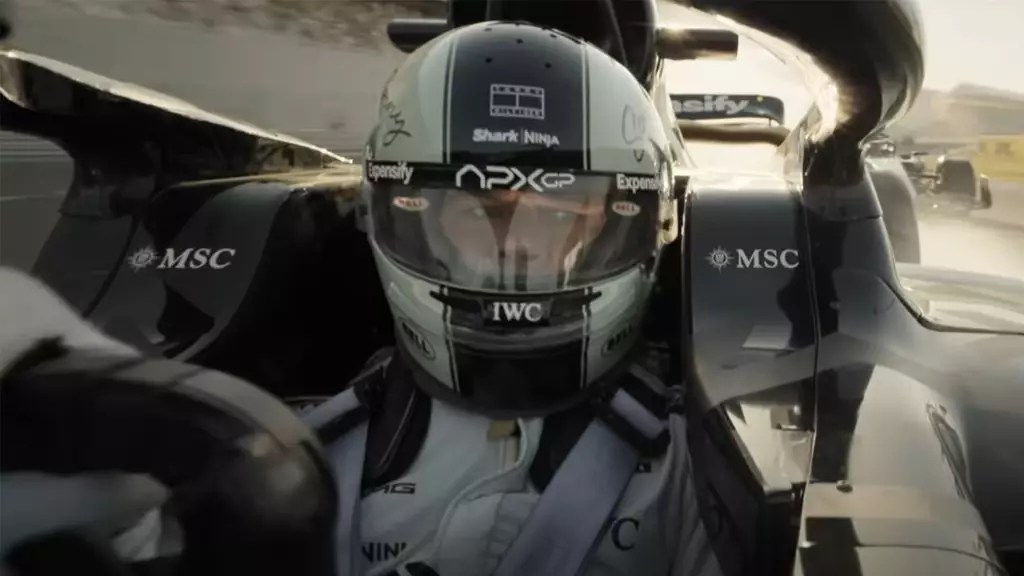In an era where streaming has steadily chipped away at traditional cinema attendance, the emergence of Apple’s “F1” movie as a massive theatrical hit is nothing short of a seismic shock. Pulling in an eye-popping $55 million-plus on opening weekend across 3,661 theaters, this Jerry Bruckheimer-produced, Brad Pitt-led Formula One spectacle has not only broken Apple’s records for original theatrical releases but also injected much-needed vigor into a post-pandemic movie business struggling to recapture audience enthusiasm. Apple, long known for cautious and middling theatrical efforts, suddenly finds itself in a league previously dominated by traditional Hollywood studios. This is not merely a financial win; it is an unequivocal statement about the power of strategic content alignment and marketing — qualities the film industry has sorely missed in recent blockbuster flops.
Why Formula One? The Perfect Cultural and Commercial Storm
Formula One racing is a global fascination with a built-in passionate fandom and aspirational allure. Unlike many Hollywood franchises that stagger along without genuine international appeal, “F1” capitalizes on a worldwide audience hungry for the drama and adrenaline rush of motorsports. This isn’t a niche sport anymore — it’s a lifestyle brand, and the film smartly absorbs this cultural momentum. That Apple, typically a technology giant, would harness this to create such widespread theatrical anticipation suggests a savvy commercial sense often absent in Silicon Valley’s flirtations with content creation. This is digital ambition rubbed up against traditional entertainment muscle, executed with sophistication by Warner Bros.’ robust marketing and distribution strategies. The result: a rare synergy that commands respect and, crucially, ticket sales.
Brad Pitt’s Unexpected Box Office Comeback
The film’s success also signals a rejuvenation of Brad Pitt as a genuine box office draw. The actor may often be lauded for his artistic chops but rarely as a reliable commercial lead in today’s multiplex environment. “F1” posts his second-best opening ever, trailing only behind “World War Z” from 2013, proving that while blockbuster leads might cycle in and out, a carefully crafted star vehicle paired with a compelling story can still cut through the noise. Pitt’s charismatic presence married to a high-octane sports narrative positions the film well beyond a mere marketing gimmick. It is a reminder that star power, when combined with innovative material, remains a potent formula in an age of franchise fatigue and superhero oversaturation.
Marketing Masterclass: Leveraging Social and Demographics
Apple and Warner Bros.’ promotional wizardry deserves particular acclaim. The film’s social media reach—an astounding 845.6 million across platforms—is not just a vanity metric but a testament to aggressive, targeted engagement. Most particularly striking is the 30% capture of the coveted 13-24 demographic, a group notoriously elusive for films outside of franchise juggernauts or teen-driven fare. Marketing a high-brow, adrenaline-fueled biopic about a sport many perceive as mature or niche, yet attracting a young audience, is a clear win for strategic demographic expansion. It suggests that with the right product placement and digital storytelling, even traditionally “older” or “male-skewing” genres can freshen their fan base and open up commercially viable new frontiers for theaters.
Counterprogramming, Frugality, and Cautionary Tales
Contrasting “F1”’s triumph is the moderate underperformance of Universal and Blumhouse’s “M3GAN 2.0,” a horror sequel with modest production budget but similarly heavy anticipation. Despite a hefty 3,112-theater rollout, it stumbled to a $10 million opening—a far cry from expectations and a harsh reminder that a strong franchise and low costs do not guarantee commercial success. This points to a broader industry lesson: brute force distribution and sequelitis alone cannot replace creativity and cultural resonance. The horror genre’s oversaturation and waning gimmick appeal reveal the pitfalls of complacency amidst competition. Meanwhile, “F1”’s costly $200 million production investment, shared risk on prints and advertising with Warner Bros., and carefully cultivated global appeal demonstrate the payoff when quality and strategy align before cash is thrown at the problem.
The Global Imperative: Unlocking True Market Potential
What really distinguishes “F1” from countless Hollywood projects is its razor-sharp focus on international markets, where the sport facilitates immediate cultural entry points. The reported global opening projection exceeding $115 million underscores the necessity for films to think globally, not just domestically. This aligns with center-right liberal views emphasizing pragmatic internationalism and market-driven expansion. The film represents an acknowledgment that innovation in content and marketing must transcend U.S. borders if studios want to thrive amid increasing regional competition and shifting consumer habits. Apple and Warner Bros.’ partnership here might well become the blueprint for how studios must execute big-budget tentpoles moving forward: local relevance with global scale, executed with operational excellence.
Cautiously Optimistic or a Harbinger of Larger Shifts?
While “F1” clearly signals a positive direction for theatrical cinema, it is also a complex lesson in risk and reward. Apple’s increased courage to invest heavily in theatrical originals paired with strategic distributors is promising but does not guarantee this model’s widespread replication, particularly as exorbitant production costs remain a barrier to entry for many. Yet, it arms studios with renewed enthusiasm to break away from the endless superhero and franchise treadmill that saturates the market. This fresh approach appeals especially to those desiring entertainment that is less formulaic and more rooted in authentic cultural phenomena. The “F1” launch is an inspiring example of how well-crafted, well-marketed adult-driven films can still find mass appeal — if studios can muster the commitment, innovation, and patience often in short supply in today’s short-sighted industry.


Leave a Reply